
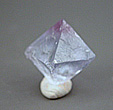
Fluorite (calcium fluoride), historically called Fluorspar, has been used in carvings and decorative objects for hundreds of years, but the availability of faceted pieces is a relatively new development. Not readily useable in jewelry due to its softness, and perfect cleavage in four directions, it is primarily a collector's gem. Faceting this material presents considerable challenges, but well cut and polished gems can be very bright and appealing. The first picture below shows a close-up of a typical piece of fluorite rough showing natural cleavages, note the steep 90 degree breaks. Although fluorite sometimes forms octahedral crystals naturally, most of the fluorite octahedrons sold to collectors are actually those which have been deliberately cleaved into that shape. (If the cleaver knows exactly where to hit the crystal, these form readily and need no polishing!).


The name from the Latin "fluere" refers to the fact that it melts easily, a property which makes it useful industrially as a flux in steel production. Other industrial uses of non-gem grade fluorite vary from the production of hydrofluoric acid to the manufacture of "opalescent" glass, to coatings for special lenses for cameras and telescopes. The latter use is occasioned by the extremely low dispersion of this mineral. (Dispersion is the splitting of white light into spectral colors -- a feat desirable in a gemstone, but inconvenient in precision optics!) Some might think that the name fluorite derives from the fluorescence shown by some specimens of the mineral, actually, just the opposite is true. The property of fluorescence was named for this mineral which many scientists used in the early studies of the phenomenon.
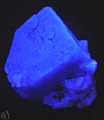
Fluorite mines are widespread, with the most important current supplies originating in Switzerland, USA, Australia, Germany, Mexico and Nambia. The largest US deposits occur in Illinois where fluorite is the official "State Mineral".
The deposits are generally formed when near surface hydrothermal waters, invade calcium rich rocks like limestone, via cracks and openings, or in the vicinity of hot springs. The crystals can take many forms most commonly massive, cubic and, on occasion, octahedral, and the well-formed ones are eagerly sought by mineral collectors. The color range of this mineral is as wide as its distribution, ranging from purple, green, blue, yellow, orange, pink and brown to multicolor with bands or swirls of contrasting colors.
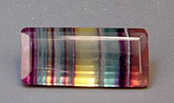
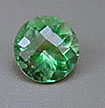

One of the most famous of all gem fluorite mines, located in Castleton, Derbyshire in the UK, and now, sadly, virtually exhausted, produced the famous "blue john". This banded, translucent, cream and blue-purple fluorite was extensively used throughout Europe over at least fifteen centuries to produce stunning vases, sculptures, and ornamental items. The very small production remaining today goes almost exclusively to custom jewelry. Quite recently a deposit of colorful and durable, highly silicated, massive fluorite was discovered in Utah, and has been given a number of fanciful names: Picasso Stone & Bertandite, to name two. More properly called "opalized fluorite" it makes attractive cabochon gems.
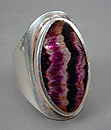
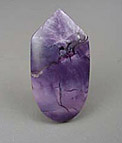
Care considerations include protecting stones from hard knocks, rapid temperature changes, and strong chemicals. Cleaning in warm water and mild soap is safe. Known enhancements are limited to plastic or resin impregnation to improve stability, and are rare in the marketplace. Due to the ready availability and low cost of natural material no synthetics are marketed.
As large crystals are common, size in a finished piece is a minor value consideration. Most banded fluorites or those in common colors are quite inexpensive and readily available as native cuts. Premium prices are obtained only for those pieces with fine faceting and polish, or those with unusual colors.